Personal Details
Born: 1 March 1882 in Ightfield, Shropshire and baptised on 11 June in Ightfield Parish Church.
Family: He was the eldest of six children born to Thomas Henry White, a groom, and his wife Catherine. He married Elizabeth Trow in 1904 in Whitchurch, Shropshire and together they had four surviving children – Thomas Henry, Ethel Mary Jane, Lilly and Samuel. Thomas also had a step-son, Arthur Trow.
Residence: At the time of his baptism the family were living in Ightfield; in 1891 he was living with his family in Green End, Whitchurch. By 1901 they had moved to 1 Railway Inn Yard, Station Road, Whitchurch. In 1911, now married with a young family, Thomas was living at 24 Grindley Brook, Whitchurch. The 1919 Absent Voters’ Register has an address of 7 Castle Hill, Whitchurch for him. In 1939 he was living at 6 George Street, Whitchurch; this was his address at the time of his death.
Employment: In 1901 he was a saddler’s apprentice; in 1911 he was a general labourer. In 1939 he was a road worker for the County Council.
Died: In 1951 in Whitchurch, aged 69, and was buried on 5 February the same year in Whitchurch cemetery.
Military Details
Regiment: Labour Corps (previously King’s Liverpool Regiment)
Rank: Private
Service Number: 46641 (previously 70603)
Date of Enlistment: Not known
Date of Discharge: Not known
Reason for Discharge: Not known
Thomas was awarded the Campaign Medals (Victory and British War Medals)

The British War Medal (also known as 'Squeak') was a silver or bronze medal awarded to officers and men of the British and Imperial Forces who either entered a theatre of war or entered service overseas between 5th August 1914 and 11th November 1918 inclusive. This was later extended to services in Russia, Siberia and some other areas in 1919 and 1920. Approximately 6.5 million British War Medals were issued. Approximately 6.4 million of these were the silver versions of this medal. Around 110,000 of a bronze version were issued mainly to Chinese, Maltese and Indian Labour Corps. The front (obv or obverse) of the medal depicts the head of George V. The recipient's service number, rank, name and unit was impressed on the rim.
The Allied Victory Medal (also known as 'Wilfred') was issued by each of the allies. It was decided that each of the allies should each issue their own bronze victory medal with a similar design, similar equivalent wording and identical ribbon. The British medal was designed by W. McMillan. The front depicts a winged classical figure representing victory. Approximately 5.7 million victory medals were issued. Interestingly, eligibility for this medal was more restrictive and not everyone who received the British War Medal ('Squeak') also received the Victory Medal ('Wilfred'). However, in general, all recipients of 'Wilfred' also received 'Squeak' and all recipients of The 1914 Star or The 1914/1915 Star (also known as 'Pip') also received both 'Squeak' and 'Wilfred'. The recipient's service number, rank, name and unit was impressed on the rim.

